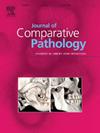伴侣动物的喉骨化病
IF 0.8
4区 农林科学
Q4 PATHOLOGY
引用次数: 0
摘要
喉骨化是一种异位骨化形式,在人类中被广泛认识,但在伴侣动物中很少报道,在家养动物和野生动物中有一些病例报告。通过一项回顾性的多机构研究,我们收集了提交尸检的犬和猫患者的喉部标本。记录每个病例的相关临床信息,包括年龄、品种、性别、体重和最终诊断。组织学检查评估喉软骨和气管环四个标准化解剖平面切片骨化率。犬环状软骨和甲状腺骨化率分别为70.9%(88/124)和57.2%(71/124),猫环状软骨和甲状腺骨化率分别为11.1%(3/27)和3.7%(1/27)。不同种间的患病率差异显著。有趣的是,环状骨化与体重(P <0.001)、性别(P <0.011)和年龄(P <0.005)相关,体型较大和年龄较大的男性骨化率较高。狗的甲状腺骨化仅与体重变量有显著差异(P <0.001),大型犬的得分较高。通过logistic回归模型,体重被确定为狗环状软骨和甲状腺软骨骨化生的危险因素。骨化评分与并发吸入性肺炎和食管肥大无显著差异,骨化明显的犬很少观察到原发性喉部疾病。因此,我们认为喉骨化是一个常见的偶然发现在狗的年龄,性别和品种的动物。喉骨化生是一种罕见的发现在猫。本文章由计算机程序翻译,如有差异,请以英文原文为准。

Laryngeal osseous metaplasia in companion animals
Laryngeal ossification is a form of heterotopic ossification widely recognized in humans and seldom reported in companion animals, with selected case reports available in domestic and wild animals. Through a retrospective multi-institutional study, we collected laryngeal specimens from canine and feline patients submitted for autopsy. The relevant clinical information, including age, breed, sex, weight and final diagnosis, was recorded in each case. Histological examination assessed the percentage ossification in four standardized anatomical plane sections of the laryngeal cartilages and tracheal rings. Cricoid and thyroid ossification was reported in 70.9% (88/124) and 57.2% (71/124) of the canine cases, respectively, and in 11.1% (3/27) and 3.7% (1/27) of the feline cases. The prevalence percentages differed significantly between the species. Interestingly, the cricoid ossification differed significantly in relation to bodyweight (P <0.001), sex (P <0.011) and age (P <0.005) with the higher ossification recorded in larger and older males. Thyroid ossification in dogs differed significantly only with the bodyweight variable (P <0.001) with higher scoring in large breeds. Through a logistic regression model, bodyweight was identified as a risk factor for osseous metaplasia in the cricoid and thyroid cartilage in dogs. The ossification score did not differ significantly with concurrent aspiration pneumonia and megaoesophagus, and primary laryngeal disease was seldom observed in dogs with marked ossification. Therefore, we suggest that laryngeal ossification is a common incidental finding in dogs in relation to the age, sex and breed of the animal. Laryngeal osseous metaplasia is a rare finding in cats.
求助全文
通过发布文献求助,成功后即可免费获取论文全文。
去求助
来源期刊
CiteScore
1.60
自引率
0.00%
发文量
208
审稿时长
50 days
期刊介绍:
The Journal of Comparative Pathology is an International, English language, peer-reviewed journal which publishes full length articles, short papers and review articles of high scientific quality on all aspects of the pathology of the diseases of domesticated and other vertebrate animals.
Articles on human diseases are also included if they present features of special interest when viewed against the general background of vertebrate pathology.

 求助内容:
求助内容: 应助结果提醒方式:
应助结果提醒方式:


